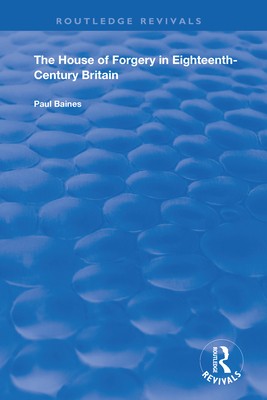
- We will send in 10–14 business days.
- Author: Paul Baines
- Publisher: Routledge
- ISBN-10: 0367195461
- ISBN-13: 9780367195465
- Format: 15.6 x 23.4 x 1.1 cm, minkšti viršeliai
- Language: English
- SAVE -10% with code: EXTRA
Reviews
Description
Published in 1999, this work offers a balanced interdisciplinary account of literary and criminal forgery as they were practised, constructed and theorized in the 18th century as a corollary of the new documents of the financial revolution: banknotes, bills of exchange and promissory notes. The book surveys the crime and its mythology, placing well-known cases such as that of Dr. William Dodd within the pattern of 400 prosecutions from the period 1715-1780. In parallel, accounts of some major instances of literary forgery are rooted in a more pervasive culture in which forgery was discovered in many developing areas of literary practice: scholarly editing, historiography and antiquarianism. One surprising aspect of this study is the extent to which literary figures were involved in matters of criminal as well as literary forgery. It is suggested that the two kinds of forgery have unexpected connections with each other through the economy of literature which, following the development of copyright, regarded the signature of authorship as the legal site of literary authenticity, and through the economic and legal culture of forgery prosecutions, in which bogus writing came to signify a whole range of problems of personal and literary character. The study is based on a very large body of diverse material, from major texts such as The Dunciad and Lives of the English Poets to hundreds of minor poems, controversial pamphlets, criminal biographies, newspapers, legal records and manuscripts.
EXTRA 10 % discount with code: EXTRA
The promotion ends in 23d.23:05:06
The discount code is valid when purchasing from 10 €. Discounts do not stack.
- Author: Paul Baines
- Publisher: Routledge
- ISBN-10: 0367195461
- ISBN-13: 9780367195465
- Format: 15.6 x 23.4 x 1.1 cm, minkšti viršeliai
- Language: English English
Published in 1999, this work offers a balanced interdisciplinary account of literary and criminal forgery as they were practised, constructed and theorized in the 18th century as a corollary of the new documents of the financial revolution: banknotes, bills of exchange and promissory notes. The book surveys the crime and its mythology, placing well-known cases such as that of Dr. William Dodd within the pattern of 400 prosecutions from the period 1715-1780. In parallel, accounts of some major instances of literary forgery are rooted in a more pervasive culture in which forgery was discovered in many developing areas of literary practice: scholarly editing, historiography and antiquarianism. One surprising aspect of this study is the extent to which literary figures were involved in matters of criminal as well as literary forgery. It is suggested that the two kinds of forgery have unexpected connections with each other through the economy of literature which, following the development of copyright, regarded the signature of authorship as the legal site of literary authenticity, and through the economic and legal culture of forgery prosecutions, in which bogus writing came to signify a whole range of problems of personal and literary character. The study is based on a very large body of diverse material, from major texts such as The Dunciad and Lives of the English Poets to hundreds of minor poems, controversial pamphlets, criminal biographies, newspapers, legal records and manuscripts.


Reviews